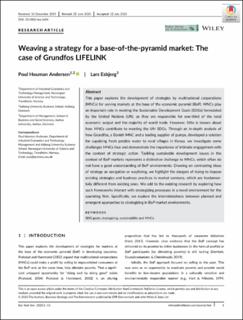| dc.contributor.author | Andersen, Poul Houman | |
| dc.contributor.author | Esbjerg, Lars | |
| dc.date.accessioned | 2020-08-21T08:54:22Z | |
| dc.date.available | 2020-08-21T08:54:22Z | |
| dc.date.created | 2020-08-19T13:10:07Z | |
| dc.date.issued | 2020 | |
| dc.identifier.citation | Business Strategy and the Environment (BSE). 2020, . | en_US |
| dc.identifier.issn | 0964-4733 | |
| dc.identifier.uri | https://hdl.handle.net/11250/2673348 | |
| dc.description.abstract | This paper explores the development of strategies by multinational corporations
(MNCs) for serving markets at the base of the economic pyramid (BoP). MNCs play
an important role in meeting the Sustainable Development Goals (SDGs) formulated
by the United Nations (UN), as they are responsible for one-third of the total
economic output and the majority of world trade. However, little is known about
how MNCs contribute to meeting the UN SDGs. Through an in-depth analysis of
how Grundfos, a Danish MNC and a leading supplier of pumps, developed a solution
for supplying fresh potable water to rural villages in Kenya, we investigate some
challenges MNCs face and demonstrate the importance of intimate engagement with
the context of strategic action. Tackling sustainable development issues in the
context of BoP markets represents a distinctive challenge to MNCs, which often do
not have a good understanding of BoP environments. Drawing on contrasting ideas
of strategy as navigation or wayfaring, we highlight the dangers of trying to impose
existing strategies and business practices in market contexts, which are fundamentally different from existing ones. We add to the existing research by exploring how
such frameworks interact with strategizing processes in a novel environment for the
operating firm. Specifically, we explore the interrelatedness between planned and
emergent approaches to strategizing in BoP market environments. | en_US |
| dc.language.iso | eng | en_US |
| dc.publisher | Wiley | en_US |
| dc.rights | Attribution-NonCommercial-NoDerivatives 4.0 Internasjonal | * |
| dc.rights.uri | http://creativecommons.org/licenses/by-nc-nd/4.0/deed.no | * |
| dc.title | Weaving a strategy for a base-of-the-pyramid market: The case of Grundfos LIFELINK | en_US |
| dc.type | Peer reviewed | en_US |
| dc.type | Journal article | en_US |
| dc.description.version | publishedVersion | en_US |
| dc.source.pagenumber | 0 | en_US |
| dc.source.journal | Business Strategy and the Environment (BSE) | en_US |
| dc.identifier.doi | 10.1002/bse.2604 | |
| dc.identifier.cristin | 1824047 | |
| dc.description.localcode | This is an open access article under the terms of the Creative Commons Attribution-NonCommercial-NoDerivs License, which permits use and distribution in any medium, provided the original work is properly cited, the use is non-commercial and no modifications or adaptations are made. © 2020 The Authors. Business Strategy and The Environment published by ERP Environment and John Wiley & Sons Ltd | en_US |
| cristin.ispublished | true | |
| cristin.fulltext | original | |
| cristin.qualitycode | 1 | |

